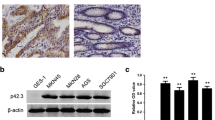Abstract
This study aims to investigate the expression and significance of EphA2 and EphrinA-1 in human gastric adenocarcinoma progression and prognosis. The expression of EphA2 and EphrinA-1 was detected in the cell lines and tissues of gastric adenocarcinoma. Different expression levels of EphA2 and EphrinA-1 were found in two cell lines. The expression of EphA2 and EphrinA-1 was significantly higher in gastric adenocarcinoma tissues than in normal tissues. Statistical analysis showed a significant correlation of EphA2 expression with the depth of tumor invasion, tumor-node-metastasis (TNM) stages, and lymph node metastasis. EphrinA-1 over-expression was significantly correlated with TNM stages and lymph node metastasis, while EphA2 expression was found to be an independent prognostic factor of postoperative gastric adenocarcinoma. In conclusion, the increased expression of EphA2 and EphrinA-1 plays an important role in the progression of human gastric adenocarcinoma, in which elevated EphA2 expression is an independent factor that indicates poor prognosis in postoperative gastric adenocarcinoma.



Similar content being viewed by others
References
American Cancer Society. Cancer facts and figures 2005. Available online at: http://www.cancer.org/downloads/STT/CAFF2005f4PWSecured.pdf.
Catalano V, Labianca R, Beretta GD, et al. Gastric cancer. Crit Rev Oncol Hematol, 2005;54:209–241. doi:10.1016/j.critrevonc.2005.01.002.
American Cancer Society. Cancer facts and figures 2008. Available online at: http://www.cancer.org/downloads/STT/2008CAFFfinalsecured.pdf.
van der Geer P, Hunter T, Lindberg RA. Receptor protein-tyrosine kinases and their signal transduction pathways. Annu Rev Cell Biol, 1994;10:251–337. doi:10.1146/annurev.cb.10.110194.001343.
Surawska H, Ma PC, Salgia R. The role of ephrins and Eph receptors in cancer. Cytokine Growth Factor Rev, 2004;15:419–433. doi:10.1016/j.cytogfr.2004.09.002.
Sulman EP, Tang XX, Allen C, et al. ECK, a human EPH-related gene, maps to 1p36.1, a common region of alteration in human cancers. Genomics, 1997;40:371–374. doi:10.1006/geno.1996.4569.
Zelinski DP, Zantek ND, Stewart JC, et al. EphA2 overexpression causes tumorigenesis of mammary epithelial cells. Cancer Res, 2001;61:2301–2306.
Kinch MS, Moore MB, Harpole DH Jr. Predictive value of the EphA2 receptor tyrosine kinase in lung cancer recurrence and survival. Clin Cancer Res, 2003;9:613–618.
Kataoka H, Igarashi H, Kanamori M, et al. Correlation of EPHA2 overexpression with high microvessel count in human primary colorectal cancer. Cancer Sci, 2004;95:136–141. doi:10.1111/j.1349-7006.2004.tb03194.x.
Xu F, Zhong W, Li J, et al. Predictive value of EphA2 and EphrinA-1 expression in oesophageal squamous cell carcinoma. Anticancer Res, 2005;25:2943–2950.
Ogawa K, Pasqualini R, Lindberg RA, et al. The ephrin-A1 ligand and its receptor, EphA2, are expressed during tumor neovascularization. Oncogene, 2000;19:6043–6052. doi:10.1038/sj.onc.1204004.
Fang WB, Brantley-Sieders DM, Parker MA, et al. A kinase-dependent role for EphA2 receptor in promoting tumor growth and metastasis. Oncogene, 2005;24:7859–7868. doi:10.1038/sj.onc.1208937.
Barranco SC, Townsend CM Jr, Casartelli C, et al. Establishment and characterization of an in vitro model system for human adenocarcinoma of the stomach. Cancer Res, 1983;43:1703–1709.
Lin CH, Fu ZM, Liu YL, et al. Investigation of SGC-7901 cell line established from human gastric carcinoma cells. Chin Med J, 1984;97:831–834.
Sobin LH, Wittekind Ch. International Union Against Cancer. TNM Classification of Malignant Tumors, 5th edn. New York: Wiley; 1997.
Herath NI, Spanevello MD, Sabesan S, et al. Over-expression of Eph and ephrin genes in advanced ovarian cancer: ephrin gene expression correlates with shortened survival. BMC Cancer, 2006;6:144. doi:10.1186/1471-2407-6-144.
Shen H, Zhang M, Minuk GY, et al. Different effects of rat interferon alpha, beta and gamma on rat hepatic stellate cell proliferation and activation. BMC Cell Biol, 2002;3:9. doi:10.1186/1471-2121-3-9.
Thaker PH, Deavers M, Celestino J, et al. EphA2 expression is associated with aggressive features in ovarian carcinoma. Clin Cancer Res, 2004;10:5145–5150. doi:10.1158/1078-0432.CCR-03-0589.
Lin YG, Han LY, Kamat AA, et al. EphA2 overexpression is associated with angiogenesis in ovarian cancer. Cancer, 2007;109:332–340. doi:10.1002/cncr.22415.
Nakamura R, Kataoka H, Sato N, et al. EPHA2/EFNA1 expression in human gastric cancer. Cancer Sci, 2005;96:42–47.
Abraham S, Knapp DW, Cheng L, et al. Expression of EphA2 and Ephrin A-1 in carcinoma of the urinary bladder. Clin Cancer Res, 2006;12:353–360. doi:10.1158/1078-0432.CCR-05-1505.
Zantek ND, Walker-Daniels J, Stewart J, et al. MCF-10A-NeoST: a new cell system for studying cell-ECM and cell-cell interactions in breast cancer. Clin Cancer Res, 2001;7:3640–3648.
Walker-Daniels J, Riese DJ 2nd, Kinch MS. c-Cbl-dependent EphA2 protein degradation is induced by ligand binding. Mol Cancer Res, 2002;1:79–87.
Kinch MS, Carles-Kinch K. Overexpression and functional alterations of the EphA2 tyrosine kinase in cancer. Clin Exp Metastasis, 2003;20:59–68. doi:10.1023/A:1022546620495.
Wu D, Suo Z, Kristensen GB, et al. Prognostic value of EphA2 and EphrinA-1 in squamous cell cervical carcinoma. Gynecol Oncol, 2004;94:312–319. doi:10.1016/j.ygyno.2004.05.019.
Han L, Dong Z, Qiao Y, et al. The clinical significance of EphA2 and Ephrin A-1 in epithelial ovarian carcinomas. Gynecol Oncol, 2005;99:278–286. doi:10.1016/j.ygyno.2005.06.036.
Ruoslahti E. Fibronectin and its integrin receptors in cancer. Adv Cancer Res, 1999;76:1–20. doi:10.1016/S0065-230X(08)60772-1.
Fang WB, Ireton RC, Zhuang G, et al. Overexpression of EPHA2 receptor destabilizes adherens junctions via a RhoA-dependent mechanism. J Cell Sci, 2008;121:358–368. doi:10.1242/jcs.017145.
Brantley-Sieders DM, Zhuang G, Hicks D, et al. The receptor tyrosine kinase EphA2 promotes mammary adenocarcinoma tumorigenesis and metastatic progression in mice by amplifying ErbB2 signaling. J Clin Invest, 2008;118:64–78. doi:10.1172/JCI33154.
Easty DJ, Guthrie BA, Maung K, et al. Protein B61 as a new growth factor: expression of B61 and up-regulation of its receptor epithelial cell kinase during melanoma progression. Cancer Res, 1995;55:2528–2532.
Duxbury MS, Ito H, Zinner MJ, et al. EphA2: a determinant of malignant cellular behavior and a potential therapeutic target in pancreatic adenocarcinoma. Oncogene, 2004;23:1448–1456. doi:10.1038/sj.onc.1207247.
Landen CN Jr, Chavez-Reyes A, Bucana C, et al. Therapeutic EphA2 gene targeting in vivo using neutral liposomal small interfering RNA delivery. Cancer Res, 2005;65:6910–6918. doi:10.1158/0008-5472.CAN-05-0530.
Acknowledgments
This work is supported by a grant from the Natural Science Foundation, Health Department of Hunan Province, China (no. C2006-008), and a grant from the Provincial Administration of Traditional Chinese Medicine, Health Department of Hunan Province, China (no. 06103). The authors declare no competing financial interests.
Author information
Authors and Affiliations
Corresponding author
Rights and permissions
About this article
Cite this article
Yuan, WJ., Ge, J., Chen, ZK. et al. Over-Expression of EphA2 and EphrinA-1 in Human Gastric Adenocarcinoma and Its Prognostic Value for Postoperative Patients. Dig Dis Sci 54, 2410–2417 (2009). https://doi.org/10.1007/s10620-008-0649-4
Received:
Accepted:
Published:
Issue Date:
DOI: https://doi.org/10.1007/s10620-008-0649-4




